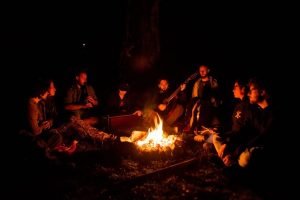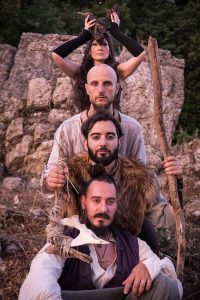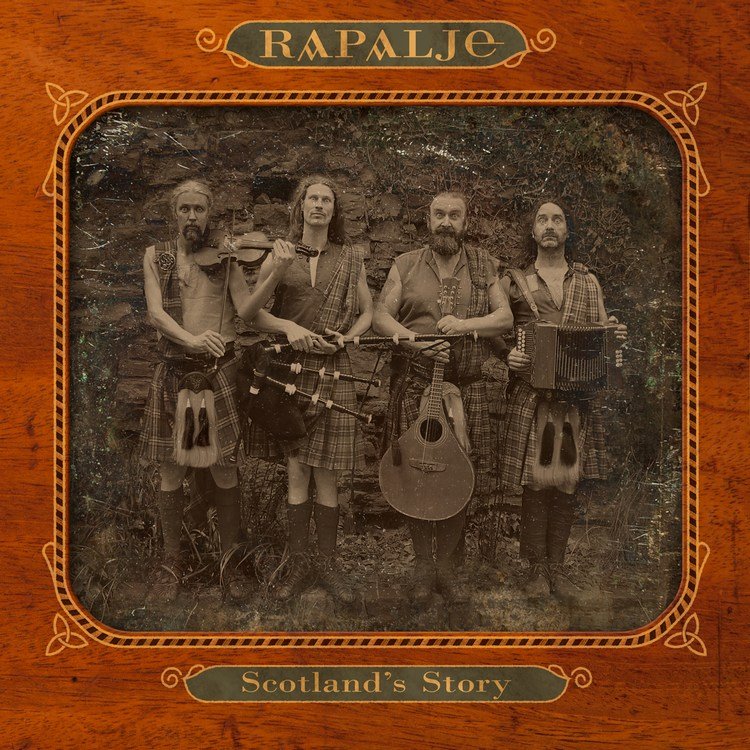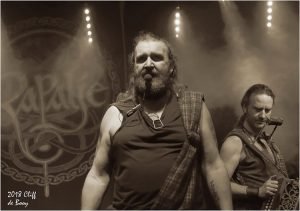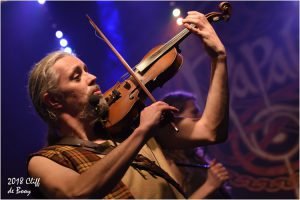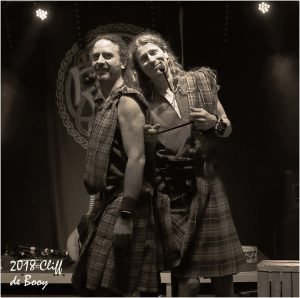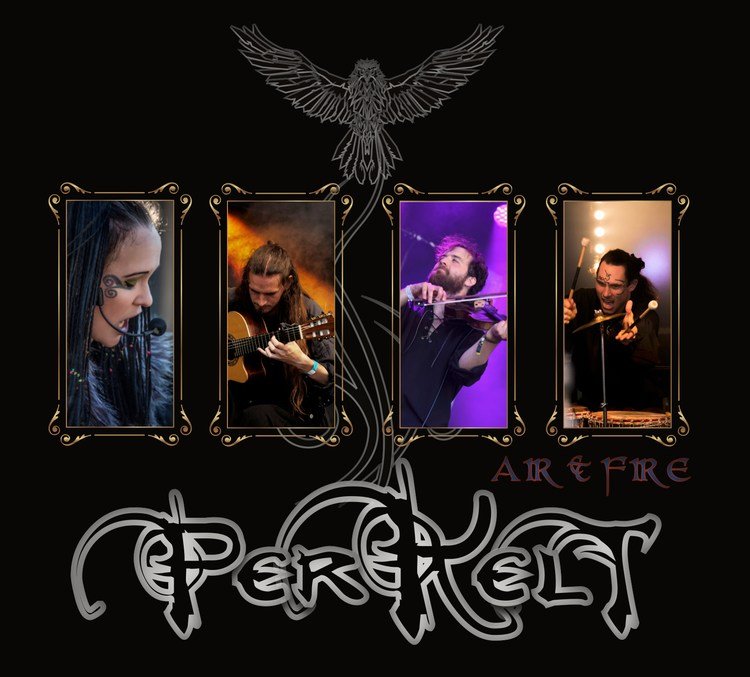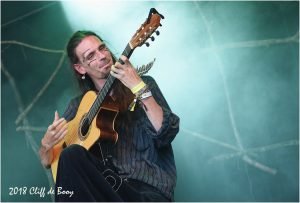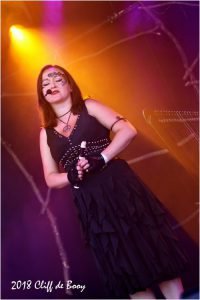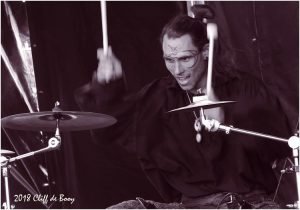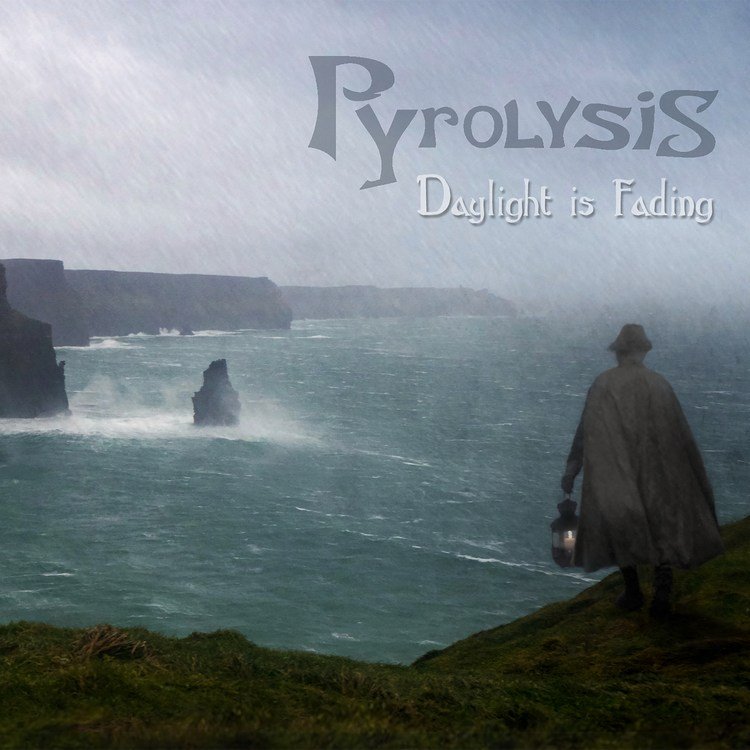
One of the coolest things for us at CeltCast is that we have seen several new bands grow from small beginnings to big shows at
Castlefest.
A good example is the band
Sunfire,
who we saw opening as a singer-songwriter act for
ThunderCrow
and is now a 5-piece band opening this year’s Castlefest with only
The Sidh
above them on the bill. Another one is
Emian,
an Italian band we had not previously heard of and whose CD Alex Sealgaire obtained and passed on to Castlefest. They became one of the most poular acts in no time.
The last example has to be
SeeD,
whom I saw playing long ago at a
gothic and fantasy fair.
They went on to debut at Castlefest together with
L.E.A.F.
and have become a crowd favourite among the Castlefest audience in the last few years.
We at CeltCast think we found another band that could make that journey. A band that has been growing steadily since their debut album in 2012. A band that makes good energetic Celtic folk, has heaps of talent, know exactly where they wanna go and are charming nice people to top it all off. That promising band is
Pyrolysis,
and they just released their newest album Daylight Is Fading.
UNIQUE SELLING POINTS
Every good band needs a unique selling point. Something that makes them stand out from the crowd.
Ye Banished Privateers
have that ‘it’ with their stageshow and their theatre style, Sunfire have ‘it’ with their western folk sound, The Sidh have their unique mix between dance and folk,
Coppelius
have ‘it’ with their unique verson of acoustic metal. And now Pyrolysis has ‘IT’ too. They found an unique sound and style that makes the difference between a nice album and a -what-the-f
[censored]-just-happened!- CD. Well done you lot, well done!!!! For me the surprise of the year.
Pyrolysis started out in 2012 as a folk metal band, but several years, a different line-up and three albums later the sound had developed into acoustic Celtic folk. In 2017 it earned them a nomination for the title best album at the
Dutch Bastaard Awards
for their third release called
Edges Of The Day.

But Stan Eimers (vocals, bodhrán, mandolin), Tim Elfring (vocals, bouzouki), Laurens Krah, (accordion), Rikke Linssen (vocals, violin, tin whistle) and new band member Joshua Kuijpers (bass guitar) were not satisfied yet, as Rikke told me. So they took their instruments, their songs, loaded it all up and sailed west to the
Dearworld Studio
for some Fieke fairy dust.
-‘ We wanted a more powerful sound.’ Rikke explains.
-‘So we ended up asking Fieke van den Hurk. After listening to several of the albums she had recorded we felt she was the right person to give us the sound we were looking for.’
-‘ It’s really something to see her work.’ Laurens adds.
-‘ Fieke really builds up a sound, layer upon layer. I have never experienced anything like that.’
The result of this collaboration has been turning its rounds in my CD player ever since it arrived, and will probably do so for many more weeks to come. But before I go into
Daylight Is Fading, let’s go back to that nominated album
Edges Of The Day.
BACK TO 2017: EDGES OF THE DAY
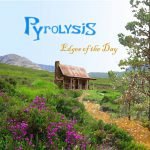
Released in 2017
Edges Of The Day is a solid Celtic folk CD. One we never reviewed at
CeltCast, but as we think it’s a album well worth listening to we make up for it now.
In general Pyrolysis makes lovely uptempo folk on
Edges Of The Day, let’s say a cool mix between the bands musical influences
Trolska Polska
meets
Silly Wizard
(a band I had personnally never heard of until Laurens pointed them out, but a cool band) with good lyrics that have meaning, good vocals and a big role for Laurens on accordion and Rikke on violin. Throwing out melody after melody to warm your hearts and move your feet.
THREE VOCALISTS!
One of the really strong points of the band is their vocals. It’s not often that a band has the luxury of three talented singers. Stan is the rock voice of the band. He has the strong lungs and that nice bit of sandpaper that you need for uptempo folk songs like
Drenchman and
Ladies Of The Lochs, but he also has the sensitivity to shine in a ballad like
Thank The Devil.Tim’s voice is a bit higher and slightly sharper, a voice that shines as a sensitive singer-songwriter, loaded with emotion. Listen to
Funniest Story and you’ll hear exactly what I mean. But he can also uses that strenght in more powerful songs like
Novio Magus or the theatrical
Captain Cray.
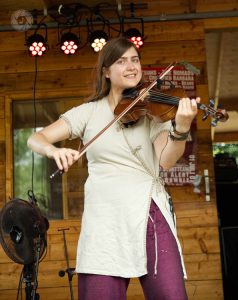
Rikke is the third lead vocalist in the band. Just as Tim she has a more fragile voice that works wonders for putting emotions across, on
I Am Crow she sounds a wee bit like
Heather Nova
and when she goes into the high notes with her soprano, it really gets an unearthly quality. I’ve really fallen in love with that song during the writing of this review. This song suits her vocal capability so well and it gives the band some extra musical possibilities.
So the variety in vocals is one strong point of the band. The other is their musicality. They are all talented musicians. The band knows how to write a good song and they have two gifted soloists which I feature and praise a lot during this review. But, as with everything, you need a good foundation before the soloists can shine. Well Stan and Tim (who played bass on the
Edges Of The Day) lay a more than solid foundation. The cool thing is that, unlike most folk rock or folk punk bands, who come from a rock background and then add some folk elements to their sound, Pyrolysis take traditional folk, play it with traditional folk instruments and than add punk rock power to it. Giving them a unique rhythm and a totally different ‘drum’ sound. As I said earlier, a unique selling point!
In retrospect – after listening to
Daylight Is Fading two weeks in a row- it is clear that some songs could have benefitted from a bit more power in the sound, a bit more ‘oomph’ so to say.. ….Enter Fieke van den Hurk (and enter Sander van der Heide who mastered the new CD.)
THE NEW ALBUM
So this is the point where I normally go deep into the music of the new CD with comparisons, examples etc. etc. etc., but not his time, at the band’s request. Rikke explains:
-‘ We would love it if the listeners were able to form their own opinion free from the influences of a review.’
Of course I will honour that request. And in a way it’s even cooler. You listeners will all get the same surprise I had when I listened to
Daylight Is Fading the first time. So instead of an in-depth review here are some of my highlights of
Daylight Is Fading, in no particular order.
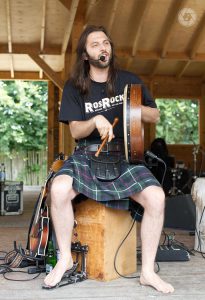
First off is
The Pilgrim, a lovely ballad, full of emotion, something that, as I said earlier, plays to Stan’s strengths. He has that ‘sandpaper ‘voice that works so well when he wants to bring strong emotions across and there are some pretty strong emotions packed in those few lines of lyrics.I should also mention Rikke’s violin playing here, Not only does she complement Stan’s voice and Laurens’ accordion, but she also plays a lovely duet with a famous guest musician,
[spoiler alert] of the well known band
[spoiler alert]. A very special guest musician indeed. That collaboration promises something for future Castlefest performances.
Captain Cray is my next favourite, if only for the intro. If the end of that intro doesn’t wake you, I don’t know what will. But there is more to
Captain Cray, much more. Tim, shines here as lead vocalist. He has to use all his theatrical singing skills to pull this one of. True Pyrolysis fans will of course recognise this song as a re-recording from the
Edges Of The Day album. The basic arrangements of the song stayed the same, it’s just differently recorded this time, adding all the theatrics it deserved from the moment the band wrote it.
Captain Cray, in this version, is definitely a favourite among my favourites.
 Donald McCillavry
Donald McCillavry, a cover from Silly Wizard, is a folk song with a good splash of dark whiskey over it. It’s built around an accordion riff that is catchy as hell. If this isn’t an instant crowd-pleaser I’ll eat up my kilt. Good vocals too, both the lead melody and the choir doing the chorus. This could be a potential single. Maybe it will be, who knows, but not the first one, that I know for sure.
Why? Well the band has told me what the first single will be and I’m sooo happy they chose this particular one. I do not want to spoil it, but trust me, it’s a good choice. Strong lyrics, really poetic but packed in a catchy melody line, good vocals from Tim again, strong choir in the end, but it’s the Irish reel they worked into it that makes the song for me. During the whole album Laurens throws out one highly addictive accordion melody after another, but this is the coolest of them all! It’s my old time favourite reel and Pyrolysis have it in their first single. I’m soooo glad my Discman has a repeat function.
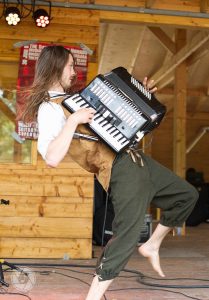
There is yet another potential single on this album,
The Pace! It is another powerful, up tempo, catchy folk song with good vocals from Stan and Laurens excelling on accordion again (yes I know it almost gets boring, but he just rocks that accordion as if he was Fieke’s kid brother). But also listen to that rhythm session in the beginning! I promise you another huge party when Pyrolysis play this intro live, the roof will come off, I’m sure of it. That intro, the violin solos, the vocals, the lyrics, the break in between, really everything fits within this song. Just take a minute to really listen to the lyrics and you’ll hear a deeper layer woven into this catchy song. I just love this. My absolute favourite amongst the favourites. Best song on the CD I think.
And there is still more to come. There is
Cooley’s Reel. Again a catchy powerful folk song. Instrumental this time with Laurens playing his accordion as if it was on fire. Who needs an electric guitar solo if you have Laurens on accordion. But the best bit is the quirky a cappella choir the band throws out at 2/3th of the sing. Brilliant stuff. Well done!
Witch Hunt has a cool dynamic intro sliding effortlessly into this, mostly, instrumental song. The combination of the bands writing skills and Fieke’s sound engineering skills works wonders here. There isn’t much singing in Witch Hunt but when they do Pyrolysis feature their vocalists once more. A strong choir! And I also love those harmonies and the Celtic percussion under it.
The last song I want to pick up on is
Rainy Road. Still without giving anything away,
Rainy Road really brings out the best in Rikke’s vocals. The combination of her voice and Tim’s bouzouki alone is enough to get goose bumps, but when the song builds up strong towards the end, it is really a stunner of a ballad. A worthy end to this very good album.
Pyrolysis can be really proud of
Daylight is Fading. If you hear the huge steps the band is taking, from
In Mountains High I Stand to
Edges Of The Day, and again from that album to the present one,
Daylight Is Fading, it is really impressive. If they keep growing like this I’m sure that, in a few years time Pyrolysis will be at the top of the Dutch folk scene.
In the meantime,
Royal Spuds,
Ye Banished Privateers, I give you your supporting act for this coming season. And you better bring your A game, ’cause if this CD is anything to go by, Pyrolysis are gonna tear the stage down!!
– Cliff
– Editor: Diane Deroubaix
– Sleeve art picture:Kev L. Smith
– Sleeve art design: Rikke Linssen
– Pictures:
Marielle Groot Obbink
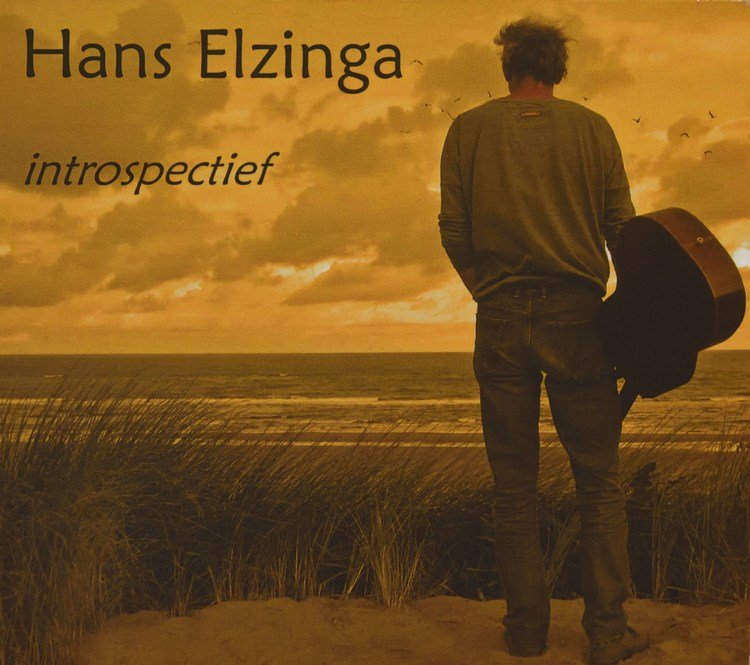
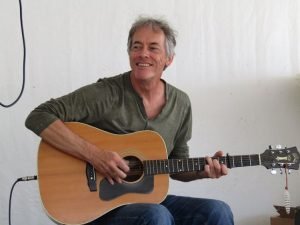 Hans is a D.I.Y artist and a very, very talented one for that matter. He composed all the songs, played all the guitar most of the flute and whistle. He often – during live performances at least – uses a loop pedal so he can accompany himself on rhythm guitar while he plays the guitar- or flute solos. He also made his own nylon string flamenco guitar, and he deliberately uses heavier strings for the 1st and 6th position on his steel-string guitar, so he can get the lower, more rich sound he is looking for. Combine a musician like this – somebody clearly seeking his own way in music- with Fieke van den Hurk and something really special starts to happen. As we all know Fieke will also go the extra- sometimes unconventional- mile to find that specific sound an instrument, a song or even a single note needs, so combine those two together and you get a silver disc filled with magic.
If you also add Rob Musters on soprano sax, Davide Lionette on percussion, Stan Stolk -former
Flairck–
on double bass ánd Parsley colleague Maaike van der Waal on Irish flute, then heaven opens for the true music lover.
With me talking so much about compositions and acoustic guitars it’s easy to think Introspective consists of classical guitar recitals. When you look at the song titles, De Klank Van Wierook, Sterrenlicht, Dryadendans, you are just as likely to think Introspective is a new age music album. Neither are true. All songs are true and proper pop songs, with a clear start and finish and a down to earth feel to it. A soulful feel as well. Sometimes the songs are clean ballads, sometimes bluesy grooves, sometimes jazzy improvisations and sometimes even acoustic prog-pop soundscapes. (I didn’t even know those existed, but Hans plays them.) He himself refers to 80’s acts like
Genesis
or
Pat Metheny
as possible references. With his slightly bluesy, soulful, clean way of playing, I would like to add the acoustic segments played by
Mark Knopfler
in his 80’s
Dire Straits
days and the solo work of
Tommy Bolin:
one of the former solo guitarists of
Deep Purple
that sadly passed away way too soon. (Just give Gypsy Soul a listen and you’ll know what I mean)
Hans is a D.I.Y artist and a very, very talented one for that matter. He composed all the songs, played all the guitar most of the flute and whistle. He often – during live performances at least – uses a loop pedal so he can accompany himself on rhythm guitar while he plays the guitar- or flute solos. He also made his own nylon string flamenco guitar, and he deliberately uses heavier strings for the 1st and 6th position on his steel-string guitar, so he can get the lower, more rich sound he is looking for. Combine a musician like this – somebody clearly seeking his own way in music- with Fieke van den Hurk and something really special starts to happen. As we all know Fieke will also go the extra- sometimes unconventional- mile to find that specific sound an instrument, a song or even a single note needs, so combine those two together and you get a silver disc filled with magic.
If you also add Rob Musters on soprano sax, Davide Lionette on percussion, Stan Stolk -former
Flairck–
on double bass ánd Parsley colleague Maaike van der Waal on Irish flute, then heaven opens for the true music lover.
With me talking so much about compositions and acoustic guitars it’s easy to think Introspective consists of classical guitar recitals. When you look at the song titles, De Klank Van Wierook, Sterrenlicht, Dryadendans, you are just as likely to think Introspective is a new age music album. Neither are true. All songs are true and proper pop songs, with a clear start and finish and a down to earth feel to it. A soulful feel as well. Sometimes the songs are clean ballads, sometimes bluesy grooves, sometimes jazzy improvisations and sometimes even acoustic prog-pop soundscapes. (I didn’t even know those existed, but Hans plays them.) He himself refers to 80’s acts like
Genesis
or
Pat Metheny
as possible references. With his slightly bluesy, soulful, clean way of playing, I would like to add the acoustic segments played by
Mark Knopfler
in his 80’s
Dire Straits
days and the solo work of
Tommy Bolin:
one of the former solo guitarists of
Deep Purple
that sadly passed away way too soon. (Just give Gypsy Soul a listen and you’ll know what I mean)
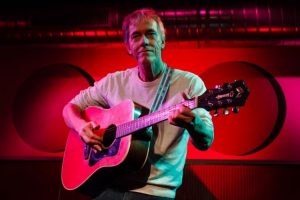 Many of Hans’ songs remind me of the acoustic guitar sections that were so common in the music of ’70s and ’80s- just think of
Pink Floyd’s
intro of Wish You Were Here, Dire Straits’ Telegraph Road or Once Upon A Time In The West, But where bands of those days then went into the rock part, or the voices came in, Hans keeps it acoustic, the voices replaced by either his lead guitar melody or the flute/whistle tunes he plays. And I’m loving every note of it.
Now I won’t go into every song individually, that would be silly – for one how many times can you say this is beautiful acoustic guitar music before it gets boring to read- So I’ll just pick out my favorites as I listen and comment on those.
My first favorite is opening song De Klank Van Wierook – the sound of essence- Just as essence this song fills your whole room with gentle, beautiful (first time) guitar chords but, as I said before, in a pleasant ‘grounded’ way. It’s a song, not a floating spacy soundscape. I love how this song just seems to slow down time and make you feel all relax in your mind. The soothing low whistle part just adds to that feel perfectly. The best cure against stress I used in a loooong time.
Lu Core Meu is partly inspired by a painting from
Johfra
called “Het vertrek van de tempelschatten, and partly by a south Italian folk song: Lu Rusciu Te Le Mare. The beginning of the song has this slight Mediterranean, slightly Spanish feel to it. That feel ends when Hans starts looping the second guitar theme he plays and starts playing bamboo flute over it. The loop has a hypnotizing effect, used just as effectively as a certain
Mike Oldfield
did many decades ago in songs like Incantations part 2. The mesmerizing bamboo flute gives this song a lovely pagan folk feel.
If I wasn’t calm by now, the sound of waves, used as an intro for the song Golven -waves- will do the trick quite nicely. But not only the sound effect does. Hans’ beautiful (second time) guitar melody again has that calming tranquil effect. Listening to Golven I also find it unbelievable how much ‘sound’ Fieke manages to pull out of a single guitar. It is as if every string has its own little microphone. Astonishing work.
The title song Introspective, as almost all the songs on this album, starts with a ‘simple’ but beautifully (third time) calming guitar melody. In all his compositions Hans takes his time to develop these melodies further and further, and Introspective with its length of 9:12 minutes is no exception. And the best bit: every note is there for a reason, it has a place and a meaning. therefore the music flows through your mind as a total bliss of calm notes. Then, in this song Introspective, the pace picks up, the energy level rises and percussionist Davide Lionetti joins in while Hans’ whistle playing turns this calm peaceful bit of guitar music into a weird acid jazz acoustic rock thing. It is as if I’m back to the days when I heard my first Flairck album. Peter Weekers, then Flute player of this groundbreaking Dutch formation, could literally talk with his flute, something I also know from Acid jazz rockers
Sweet Smoke;
SeeD‘s
lovely flute player Koen van Egmond and, now also from Hans Elzinga. Easily one of my favourite bits on this impressive album.
Talking about Flairck, one of the many former Flairck members Stan Stolk plays double bass on Sterrenlicht – starlight- he is, after Percussionist Davide Lionetti, the second guest musician to appear on Introspective, in this song together with Rob Musters on soprano sax.
Sterrenlicht was written while Hans was playing on the
Taribush Kuna festival
in the art installation of Bart Ensing and
Lidwina Charpentier.
A fairylike experience he says, never to forget.
So you might think this could finally turn new age-ish. Not Hans, we go jazz, easy jazz, think
Gare Du Nord
without the beats. Lovely calming again, but always grounded, it always serves the song. This is the music you want to hear in a small amphitheatre. With some easy lights and everybody sinking in real comfy in a huge pile of pillows instead of hard theatre chairs. (That would be a magical experience, a concert played by Hans like that.)
Drempel – threshold- has a soulful acoustic Mark Knopfler feel to it and would also fit perfectly in that pillow themed concert. The seventh song, Dryadendans – dryads dance-, is another song that has all the ingredients for a pagan folk- or new age song in its title and in the explanation about its origin in the booklet. But again no. The song flows from a typical Hans Elzinga solo acoustic guitar opening into lovely acoustic prog-pop, then into some prog rock meets Dire Straits as Hans brings that low 6th string into full use. I didn’t know acoustic prog rock existed, but Hans is playing it right here, right now. What a lovely section around that 4-minute mark.
And things are about to get even better. (better if you have the same taste for music as I have that is.) Hans brings in Stan Stolk and Rob Musters one more time for another song based upon a Johfra painting: Middernachtmystie -Midnight Mystery-. This song has Flairck written al over it. Strong guitar chords, a lovely free jazz improvisation part by saxophonist Rob, Hans his intriguing style of talking whistle cutting through the music. This is really the highlight of the CD for me, I wouldn’t be surprised if this was done in one recording session, it sure feels like it. It has this feel of musicians starting a song, flowing with it, not knowing when it will end, not caring about that anyway and a sound genius capturing it all. To be a fly on the wall at that moment. I really wish I was.
Just as Flairck does, Hans brings down the intensity of the song halfway through again for a lovely bit of calming flute and beautiful (fifth time, is it getting boring already?) Spanish style guitar. But not for long. Rob’s Soprano sax starts ripping that calm moment to pieces again, quick to be followed by Hans’ spoken whistle improvisations. In one word, A-MA-ZING.
Well, that -only point out a few of my favorite bits- idea turned out nicely. NOT! With the ninth song Onder De Oude Eik – under the old oak tree- we are at the end of Introspective and I mentioned them all! It says a lot about this album actually. Introspective is a highlight that lasts 54:09 minutes.
Timeless acoustic guitar music at its very very best.
Video
Café Acoustique
shared with kind permission of
Omroep Heemskerk.
– Cliff
Editor: Sara Weeda
Sleeve art: Nienke Cleveringa
Many of Hans’ songs remind me of the acoustic guitar sections that were so common in the music of ’70s and ’80s- just think of
Pink Floyd’s
intro of Wish You Were Here, Dire Straits’ Telegraph Road or Once Upon A Time In The West, But where bands of those days then went into the rock part, or the voices came in, Hans keeps it acoustic, the voices replaced by either his lead guitar melody or the flute/whistle tunes he plays. And I’m loving every note of it.
Now I won’t go into every song individually, that would be silly – for one how many times can you say this is beautiful acoustic guitar music before it gets boring to read- So I’ll just pick out my favorites as I listen and comment on those.
My first favorite is opening song De Klank Van Wierook – the sound of essence- Just as essence this song fills your whole room with gentle, beautiful (first time) guitar chords but, as I said before, in a pleasant ‘grounded’ way. It’s a song, not a floating spacy soundscape. I love how this song just seems to slow down time and make you feel all relax in your mind. The soothing low whistle part just adds to that feel perfectly. The best cure against stress I used in a loooong time.
Lu Core Meu is partly inspired by a painting from
Johfra
called “Het vertrek van de tempelschatten, and partly by a south Italian folk song: Lu Rusciu Te Le Mare. The beginning of the song has this slight Mediterranean, slightly Spanish feel to it. That feel ends when Hans starts looping the second guitar theme he plays and starts playing bamboo flute over it. The loop has a hypnotizing effect, used just as effectively as a certain
Mike Oldfield
did many decades ago in songs like Incantations part 2. The mesmerizing bamboo flute gives this song a lovely pagan folk feel.
If I wasn’t calm by now, the sound of waves, used as an intro for the song Golven -waves- will do the trick quite nicely. But not only the sound effect does. Hans’ beautiful (second time) guitar melody again has that calming tranquil effect. Listening to Golven I also find it unbelievable how much ‘sound’ Fieke manages to pull out of a single guitar. It is as if every string has its own little microphone. Astonishing work.
The title song Introspective, as almost all the songs on this album, starts with a ‘simple’ but beautifully (third time) calming guitar melody. In all his compositions Hans takes his time to develop these melodies further and further, and Introspective with its length of 9:12 minutes is no exception. And the best bit: every note is there for a reason, it has a place and a meaning. therefore the music flows through your mind as a total bliss of calm notes. Then, in this song Introspective, the pace picks up, the energy level rises and percussionist Davide Lionetti joins in while Hans’ whistle playing turns this calm peaceful bit of guitar music into a weird acid jazz acoustic rock thing. It is as if I’m back to the days when I heard my first Flairck album. Peter Weekers, then Flute player of this groundbreaking Dutch formation, could literally talk with his flute, something I also know from Acid jazz rockers
Sweet Smoke;
SeeD‘s
lovely flute player Koen van Egmond and, now also from Hans Elzinga. Easily one of my favourite bits on this impressive album.
Talking about Flairck, one of the many former Flairck members Stan Stolk plays double bass on Sterrenlicht – starlight- he is, after Percussionist Davide Lionetti, the second guest musician to appear on Introspective, in this song together with Rob Musters on soprano sax.
Sterrenlicht was written while Hans was playing on the
Taribush Kuna festival
in the art installation of Bart Ensing and
Lidwina Charpentier.
A fairylike experience he says, never to forget.
So you might think this could finally turn new age-ish. Not Hans, we go jazz, easy jazz, think
Gare Du Nord
without the beats. Lovely calming again, but always grounded, it always serves the song. This is the music you want to hear in a small amphitheatre. With some easy lights and everybody sinking in real comfy in a huge pile of pillows instead of hard theatre chairs. (That would be a magical experience, a concert played by Hans like that.)
Drempel – threshold- has a soulful acoustic Mark Knopfler feel to it and would also fit perfectly in that pillow themed concert. The seventh song, Dryadendans – dryads dance-, is another song that has all the ingredients for a pagan folk- or new age song in its title and in the explanation about its origin in the booklet. But again no. The song flows from a typical Hans Elzinga solo acoustic guitar opening into lovely acoustic prog-pop, then into some prog rock meets Dire Straits as Hans brings that low 6th string into full use. I didn’t know acoustic prog rock existed, but Hans is playing it right here, right now. What a lovely section around that 4-minute mark.
And things are about to get even better. (better if you have the same taste for music as I have that is.) Hans brings in Stan Stolk and Rob Musters one more time for another song based upon a Johfra painting: Middernachtmystie -Midnight Mystery-. This song has Flairck written al over it. Strong guitar chords, a lovely free jazz improvisation part by saxophonist Rob, Hans his intriguing style of talking whistle cutting through the music. This is really the highlight of the CD for me, I wouldn’t be surprised if this was done in one recording session, it sure feels like it. It has this feel of musicians starting a song, flowing with it, not knowing when it will end, not caring about that anyway and a sound genius capturing it all. To be a fly on the wall at that moment. I really wish I was.
Just as Flairck does, Hans brings down the intensity of the song halfway through again for a lovely bit of calming flute and beautiful (fifth time, is it getting boring already?) Spanish style guitar. But not for long. Rob’s Soprano sax starts ripping that calm moment to pieces again, quick to be followed by Hans’ spoken whistle improvisations. In one word, A-MA-ZING.
Well, that -only point out a few of my favorite bits- idea turned out nicely. NOT! With the ninth song Onder De Oude Eik – under the old oak tree- we are at the end of Introspective and I mentioned them all! It says a lot about this album actually. Introspective is a highlight that lasts 54:09 minutes.
Timeless acoustic guitar music at its very very best.
Video
Café Acoustique
shared with kind permission of
Omroep Heemskerk.
– Cliff
Editor: Sara Weeda
Sleeve art: Nienke Cleveringa


